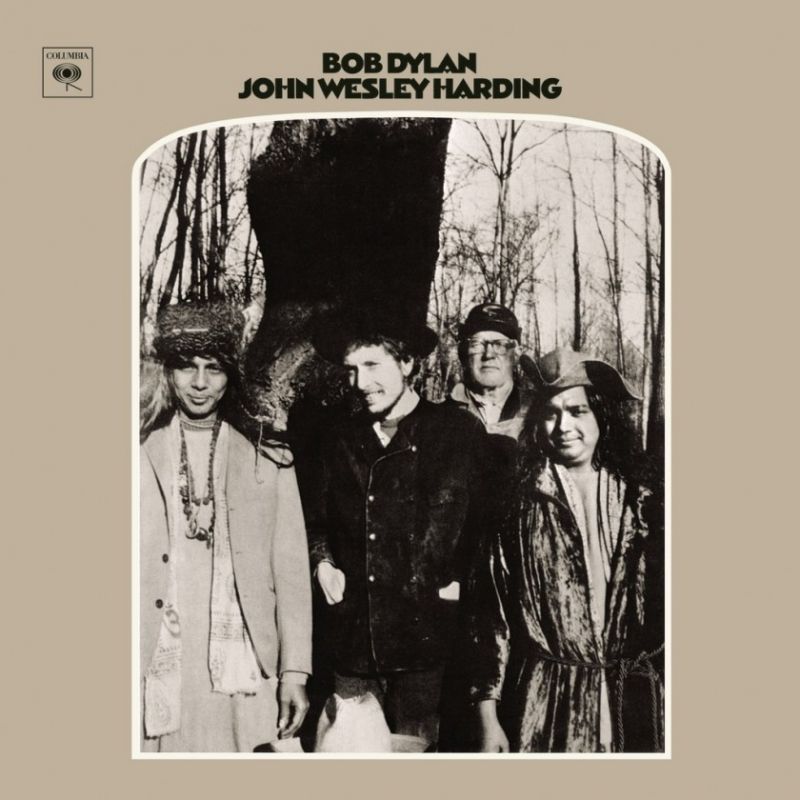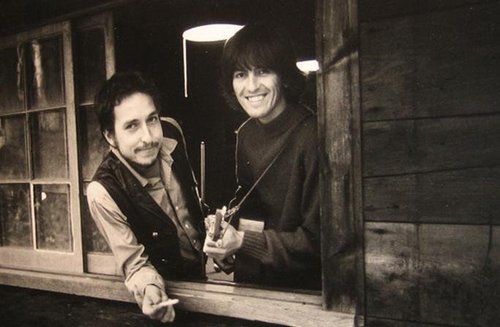JW: John Wesley Harding – why did you call the album that?
BD: We… I called it that because I had that song John Wesley Harding. It didn’t mean anything to me. I called it that, Jann, ‘cause I had the song John Wesley Harding, which started out to be a long ballad. I was gonna write a ballad on… Like maybe one of those old cowboy… You know, a real long ballad. But in the middle of the second verse, I got
tired. I had a tune, and I didn’t want to waste the tune, it was a nice little melody, so I just wrote a quick third verse, and I recorded that. But it was a silly little song….
~Bob Dylan to Jann Wenner November 29, 1969
This quiet masterpiece, which manages to sound both authoritative and tentative (a mix that gave it a highly contemporary feel), is neither a rock nor a folk album—and certainly isn’t folk-rock. It isn’t categorisable at all.
~Michael Gray (The Bob Dylan Encyclopedia)
47 years ago Bob Dylan entered Columbia Studio A, Nashville Tennessee tempting his third (and final) recording session for “John Wesley Harding”.
Some background from wikipedia:
Dylan went to work on John Wesley Harding in the fall of 1967. By then, 18 months had passed since the completion of Blonde on Blonde. After recovering from the worst of the results of his motorcycle accident, Dylan spent a substantial amount of time recording the informal basement sessions at West Saugerties, New York; little was heard from him throughout 1967. During that time, he stockpiled a large number of recordings, including many new compositions. He eventually submitted nearly all of them for copyright, but declined to include any of them in his next studio release (Dylan would not release any of those recordings to the commercial market until 1975′s The Basement Tapes; and by then, some of those recordings had been bootlegged, usually sourced from an easy-to-find set of publisher’s demos). Instead, Dylan used a different set of songs for John Wesley Harding.
It is not clear when these songs were actually written, but none of them has turned up in the dozens of basement recordings that have since surfaced. According to Robbie Robertson, “As I recall it was just on a kind of whim that Bob went down to Nashville. And there, with just a couple of guys, he put those songs down on tape.”
Those sessions took place in the autumn of 1967, requiring less than twelve hours over three stints in the studio.
Dylan brought to Nashville a set of songs similar to the feverish yet pithy compositions that came out of the Basement Tapes sessions. They would be given an austere sound sympathetic to their content. When Dylan arrived in Nashville, producer Bob Johnston:
“he was staying in the Ramada Inn down there, and he played me his songs and he suggested we just use bass and guitar and drums on the record. I said fine, but also suggested we add a steel guitar, which is how Pete Drake came to be on that record.”
Dylan was once again recording with a band, but the instrumentation was very sparse. During most of the recording, the rhythm section of drummer Kenneth A. Buttrey and bassist Charlie McCoy were the only ones supporting Dylan, who handled all harmonica, guitar, piano, and vocal parts.
“I didn’t intentionally come out with some kind of mellow sound……. I would have liked … more steel guitar, more piano. More music … I didn’t sit down and plan that sound.”
~Bob Dylan 1971This album is no cheap thrill. It is, though, a most serious, darkly visionary exploration of the myths and extinct strengths of America; its Calvinist spirit gives it an eerie power in mixing the severely biblical with a surreal 19th century, American-pioneer ethos.
~Michael Gray (The Bob Dylan Encyclopedia)
Studio A
Columbia Recording Studios
Nashville, Tennessee
November 29, 1967, 6 pm – midnight.
Produced by Bob Johnston
Songs:
- The Wicked Messenger
A wicked messenger falleth into mischief: but a faithful ambassador is health. —Proverbs 13:17
–
There was a wicked messenger
From Eli he did come
With a mind that multiplied the smallest matter
When questioned who had sent for him
He answered with his thumb
For his tongue it could not speak, but only flatter
–
- I’ll Be Your Baby Tonight
“..the relaxed richness of Dylan’s voice tells us a true healing has taken place in the course of recording the album. Good news indeed. The harmonica-playing alone is evidence of transformation.
~ Paul Williams (Bob Dylan Performing Artist I: The Early Years 1960-1973)
- Down Along The Cove
Down along the cove
I spied my true love comin’ my way
Down along the cove
I spied my true love comin’ my way
I say, “Lord, have mercy, mama
It sure is good to see you comin’ today”
- Dear Landlord
“Dear Landlord is Dylan’s most heartfelt performance on the album, the most liquid, open-throated…
Some of the landlords we can reasonably imagine Dylan singing to here include his manager, his record company, his audience;… his country. .. Dear Landlord features some great drumming. Dylan’s piano playing is fiery,…”
~ Paul Williams (Bob Dylan Performing Artist I: The Early Years 1960-1973)
All songs released on “John Wesley Harding” – December 27, 1967.
Personnel:
- Bob Dylan (vocal, guitar & harmonica),
- Charlie McCoy (bass),
- Kenneth Buttrey (drums).
- Peter Drake (Steel guitar) on 3 & 4
–
Related posts found -> Recording Sessions
References:
- Still On The Road – Olof Björner
- Bob Dylan: The Recording Sessions – Part one – by Michael Krogsgaard
-Egil




Drifters Escape-when my son was young , we’d sing it together. Help me in my weakness-who hasn’t uttered those words in life?
Not able to listen to the music.
Just checked it, every song works fine here (Norway)
I love this album and the outtakes have become a bit of a holy grail for me. Why they’ve never surfaced I don’t know as almost everything Bob did was kept securely for posterity so I’m hoping Columbia will one day (milk) this situation and let me hear (buy) them.
“Dear Landlord” is one of his under-appreciated songs. Just love it every time I hear it.
Personnel does not indicate who played piano. Can I assume it was Dylan?
Probably Dylan.